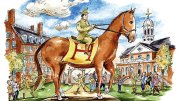1914
Parading with a Harvard banner may be a criminal offense. The Massachusetts legislature, responding to the Lawrence textile strike, adopts an act stating: “No red or black flag, and no banner, ensign or sign having upon it any inscription opposed to organized government, or which is sacrilegious, or which may be derogatory to public morals, shall be carried in parade within this commonwealth.” Undergraduates, loyal “both to the law and to Harvard,” march to the Stadium for the Princeton game “under a large white banner bearing a crimson H.”
1919
“As horses still form important means of traction for artillery in the field,” students enrolled in Harvard’s military science department receive equitation training two afternoons a week, using 50 horses and other equipment provided by the federal government.
1929
The two newest Houses, now under construction for September 1930 occupancy, have been named for Harvard’s first and present presidents, Dunster and Lowell.
1944
The Chinese Ministry of Education establishes five scholarships at Harvard for non-Chinese who have “shown merit in at least one year’s study” in some China-related field.
1954
Radcliffe celebrates its 75th anniversary.
1999
President Neil L. Rudenstine joins the Cambridge and Boston mayors to announce Harvard’s pledge to boost affordable housing in both cities: a $20-million, 20-year loan to community groups; a $1-million pool for grants for policy analysis and new housing programs; and a faculty committee to oversee the loan and grants, conduct research, and advise the nonprofit groups.
2014
The University unveils an ambitious five-year sustainability plan, focused on energy and emissions, campus operations, nature and ecosystems, health and well-being, and culture and learning.
Harvard University Press launches the Murty Classical Library of India, complementing its series of Loeb Greek and Latin texts; I Tatti Renaissance Library; and the Dumbarton Oaks Medieval Library.





